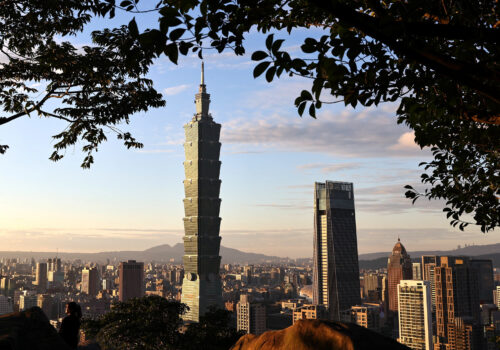Guam is a key logistics hub for US military posture in the Pacific. Located 4,000 miles west of Hawaii, Guam is twice as close to Beijing as Honolulu. As a US territory, Guam provides forward positioning from which the military can organize and launch missions without requiring host-nation approval, a distinct advantage over other overseas bases. This makes Guam vital to US defense strategy in a region shaped by rising tensions in the South China Sea and Taiwan Strait.
As five thousand Marines relocate from Okinawa to Guam, the island’s energy infrastructure, already strained from frequent outages and limited redundancy, faces increased load requirements due to new operational demands. To maintain uninterrupted power and ensure mission readiness, the Department of Defense (DOD) must fortify Guam’s energy infrastructure against cyber, natural, and kinetic threats.
The DOD in Guam
Guam hosts several vital military assets across all service branches. Naval Base Guam hosts Submarine Squadron 15’s five nuclear-powered fast-attack submarines and the Navy’s only two forward-deployed submarine tenders, which support vessels in the 5th and 7th Fleet areas. Guam’s Navy Munitions Command plays a critical role as a Tomahawk missile loading site, enabling submarine strike capabilities in the Pacific.
Andersen Air Force base hosts key resupply efforts, boosting the largest munitions stockpile in the Air Force and refueling aircraft like B2s and F-35s. Andersen also serves as a primary site for joint exercises with Pacific allies, including the annual Cope North trilateral exercise with Japan and Australia.
These mission-critical operations depend on a secure energy supply. A disruption of power on Guam’s military bases could delay fueling and maintenance operations, interfere with DOD cargo unloading on the island, and inhibit communications and radar.
Guam’s energy portfolio
Guam’s military installations rely primarily on Guam Power Authority (GPA), a public utility and the island’s only power company. While the military maintains some backup generation capacity such as the Navy’s 18 megawatt (MW) Orote Point plant, the DOD depends on GPA assets in Guam. Ninety percent (395 MW) of Guam’s energy generation comes from petroleum-fired power plants, which Guam is fully import reliant on. The rest of GPA’s power comes from renewables, primarily its two solar farms.
GPA describes a “critical shortfall” of power generation supply in Guam due to aging infrastructure and setbacks in opening a new power plant due to typhoon damage. GPA’s two largest capacity generator units, Cabras 1 and 2, are fifty years old. Concerns about Guam’s energy security were cited in a report accompanying the National Defense Authorization Act for fiscal year (FY) 2025, in which Congress noted concerns about weekly outages at Navy submarine piers. In addition to shortfalls in power generation, Guam’s energy infrastructure is prone to cyber, natural disaster, and physical threats.
Threats to Guam’s energy infrastructure
Cyberattacks
Guam’s geostrategic location makes its infrastructure a prime target for adversarial threats. Chinese state-sponsored cyber groups known as Volt Typhoon and Salt Typhoon have already demonstrated they can access military and critical infrastructure systems in Guam and the continental United States.
In 2023, Microsoft disclosed that Volt Typhoon had targeted critical infrastructure organizations in Guam through stealthy “living-off-the-land” techniques that aim to disguise malicious activity as routine network traffic. These attacks allowed Volt Typhoon to potentially disrupt key water and energy controls, and in some cases, the hackers were able to access camera surveillance systems at facilities. Chinese cyber groups were also responsible for breaches of California’s grid operator and a small Massachusetts power utility.
The director of the National Security Agency’s Cybersecurity Collaboration Center confirmed that Volt Typhoon focuses on targets in the Indo-Pacific region, indicating that cyber threats to Guam’s infrastructure are likely to continue as part of a broader attempt to weaken the United States’ ability to respond to potential conflict in the Pacific.
Natural disasters
Guam’s location in the Pacific’s “typhoon alley” makes its energy system vulnerable to natural disasters. In 2023, Typhoon Marwar struck the island, leaving 98 percent of the island without power, including at Andersen Air Force Base. Restoring power to the entire island—including repairing damaged transmission lines, substations, and other infrastructure—cost GPA $33 million and took nearly two months to complete.
Guam’s infrastructure remains insufficiently hardened against severe weather. Although GPA has made efforts to replace wooden utility poles with concrete and steel, overhead lines continue to be vulnerable. With only 22 percent of transmission lines and 19 percent of distribution lines buried underground, most of Guam’s grid remains exposed to high winds and storm debris, increasing the risk of outages.
Physical attacks
Power infrastructure is increasingly being targeted with physical sabotage, a vulnerability that could be exploited to disrupt power supply to key military installations. Attacks in the mainland United States, such as the 2022 substation shooting in North Carolina, demonstrate how low-tech methods can cause significant disruptions. Modified commercial drones have also been used to attack substations in Pennsylvania and Tennessee.
As emerging physical threats continue to evolve, Guam’s energy infrastructure must adapt to address them. Most of GPA’s substations are secured by chain-link fencing instead of concrete barriers, a vulnerability that could be exploited by threat actors to damage substations or the grid. Key facilities like the Piti power plant are located near major public roads, creating additional sabotage risk.
How to secure Guam’s energy system
The DOD, in partnership with GPA, should focus not only on increasing generation capacity, but also on protecting current assets from cyberattacks, natural disasters, and physical sabotage threats.
In 2024, GPA submitted a request for federal funding through the Federal Emergency Management Agency to support the One Guam Comprehensive Infrastructure Resiliency Plan, which would bury transmission lines and harden substations. Full funding has not yet been provided in FY 2025. Considering the importance of GPA’s resilience to US military operations, the DOD should coordinate with GPA to implement high-priority components of the One Guam plan, particularly those serving military installations. This includes reinforcing perimeter security by replacing standard fencing with concrete barriers to guard against physical threats, putting remaining overhead transmission lines underground, and relocating key substations to hardened indoor facilities to minimize exposure to storm damage and sabotage.
Given the persistent threats to Guam’s energy infrastructure, hardening cyber and physical defenses must go hand in hand with transforming the DOD-GPA relationship into a more integrated contingency response framework. Joint response and coordination plans from GPA and DOD for a cyberattack breach can be tested during regular coordination meetings or embedded into larger military training exercises. Military training such as the Air Force’s Resolute Force Pacific (REFORPAC) logistics and contingency response exercise could be expanded to include simulated cyberattacks on civilian infrastructure, such as GPA’s grid.
Similar training exercises have taken place at bases in the continental United States. Colorado’s Fort Carson partners with the local power utility to conduct an annual “black start” drill, simulating a power outage affecting both the base and the surrounding grid. Implementing similar field-based training exercises in Guam would allow DOD units and GPA to practice real-time coordination and refine response procedures before an actual incident occurs.
As Guam’s role in Indo-Pacific defense continues to evolve, the security of its energy infrastructure must keep pace to effectively counter emerging threats. In a region marked by rising geopolitical competition, the island’s ability to support forward-deployed forces gives the US a critical strategic advantage. Failure to secure the island’s energy infrastructure could prevent US forces from responding to military threats rapidly and decisively—undermining one of the key advantages Guam offers to defense strategy.
Emma Sampson is a former intern with the Atlantic Council Global Energy Center and a graduate student at Johns Hopkins University School of Advanced International Studies.
STAY CONNECTED
Sign up for PowerPlay, the Atlantic Council’s bimonthly newsletter keeping you up to date on all facets of the energy transition
RELATED CONTENT
OUR WORK

The Global Energy Center develops and promotes pragmatic and nonpartisan policy solutions designed to advance global energy security, enhance economic opportunity, and accelerate pathways to net-zero emissions.
Image: US Airmen assigned to the 734th Air Mobility Squadron await the arrival of US Air Force Gen. Johnny Lamontagne, Air Mobility Command commander, at Andersen Air Force Base, Guam, July 15, 2025. The 734th AMS is supporting the US Air Force’s 2025 Department-Level Exercise, enabling the capacity to execute rapid force projection, agile combat employment, and sustaining logistics in contested environments. The DLE encompasses all branches of the Department of Defense, along with the Allies and partners, employing more than 400 joint and coalition aircraft and more than 12,000 members at more than 50 locations across 3,000 miles. (US Air Force photo by Senior Airman Jordan McCoy)




